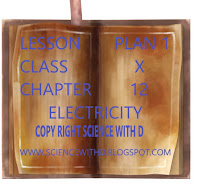CLASS 12TH PHYSICS EXPERIMENT To find the value of v for different values of u in case of a concave mirror and to find the focal length.
To find the value of v for different values of u in case of a concave mirror and to find the focal length.
Apparatus:Optical bench,concave mirror, optical needle,a meter scale.
Theory:
By Mirror formula , 1/f=1/v+1/u,
f=uv/(u+v),
where, u = distance of object from the pole of mirror
v = distance of image from the pole of mirror
Procedure:
1 Take given concave mirror and turn its reflecting surface toward a distant object to obtain image on a sheet of note book.
2 Measure the distance between mirror and image formed on the sheet. This is the rough focal length of concave mirror.
3 Clamp mirror holder in one upright and fix two optical needles in two uprights on the optical bench. Place them close to each other at one end of optical bench. Adjust their heights so that tips of the needles are at the same height as the center of the mirror. Pierce a small piece of paper into the tip of the needle near the mirror. This piece of paper is an indication that this one is our object needle.
4 Slide the uprights carrying needles away from the mirror on the optical bench to distance about 1.5 of rough focal length.
5 Slide object needle a little towards the mirror and look for its inverted image from the other end of optical bench.
6 Second needle is image needle. Pull the image needle away towards yourself and place it in such a position that when seen along the principal axis of the mirror, tip of inverted image of the object needle coincide with the tip of image needle.
7 Looking straight at their tips move your head sideways. As you move your head sideways the distance between two tips increases.
8 Pull or push the image needle towards or away from the object needle so that on moving your head sideways the two tips remains coinciding with each other. When it is achieved the image needle is in exact position of image of the object needle , and this is how parallax is removed between the two.
9 Note the positions of mirror, object needle and image needle on the optical bench.
10 Take three more readings by sliding object needle by 2-3 cm towards the mirror and by repeating steps 6 to 9.
Observations:
Rough focal length of the mirror = 15 cm
Table:
| S No | Positions of uprights (cm) | Observed distance (cm) | 1/u | 1/v | f=uv/(v+u) | |||
| Mirror P | Object O | Image I | PO=u | PI=v | ||||
| 1 | 10 | 30.5 | 66.9 | 20.5 | 56.9 | 0.0488 | 0.0179 | 15.29 |
| 2 | 10 | 32.5 | 53.8 | 22.5 | 43.8 | 0.0439 | 0.0228 | 14.99 |
| 3 | 10 | 35.6 | 46.2 | 25.6 | 36.2 | 0.0391 | 0.0276 | 15 |
| 4 | 10 | 37.2 | 43.4 | 27.2 | 33.4 | 0.0368 | 0.0299 | 14.99 |
| 5 | 10 | 39.1 | 40.9 | 29.1 | 30.9 | 0.0344 | 0.0324 | 14.99 |
Mean focal length = (15.29+14.99+15+14.99+14.99)/5 =75.26/5 = 15.05 cm
Calculations:
Graph:
Result: Focal length of concave mirror is 15.05 cm
Precautions:
1 While removing parallax, distance of our eye from image needle should be at least 30 cm.
2 Uprights can be slided along optical bench or perpendicular to it so as to remove parallax tip to tip.
3 End correction is to be applied for u and v separately.
4 Plane of concave mirror should be vertical.




Amazing site this thanks alot..
ReplyDeleteNot bad not bad
ReplyDelete